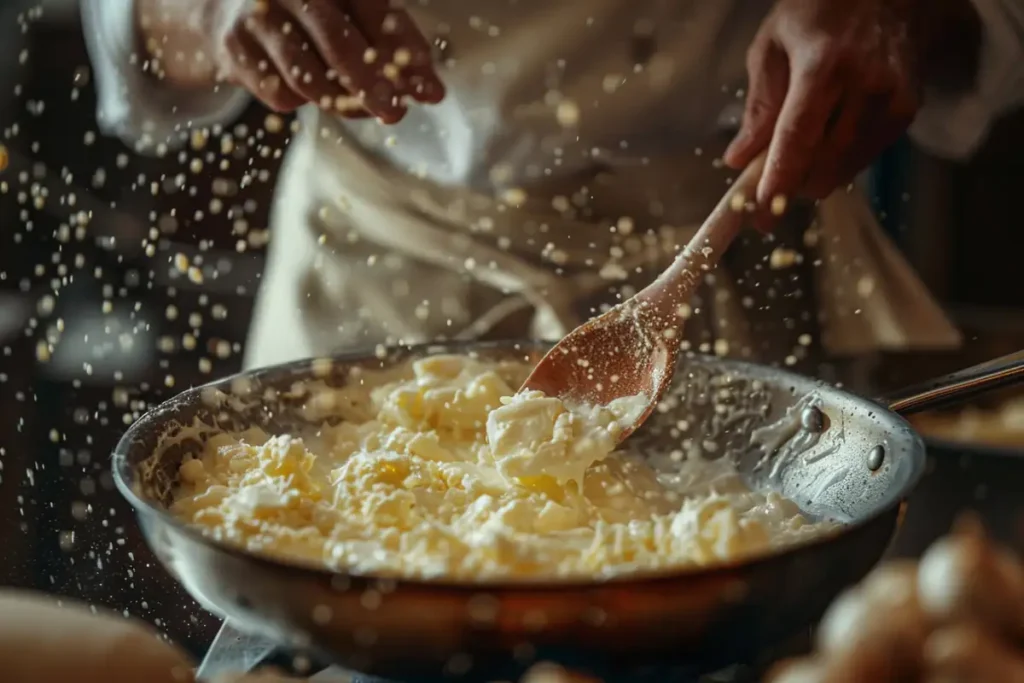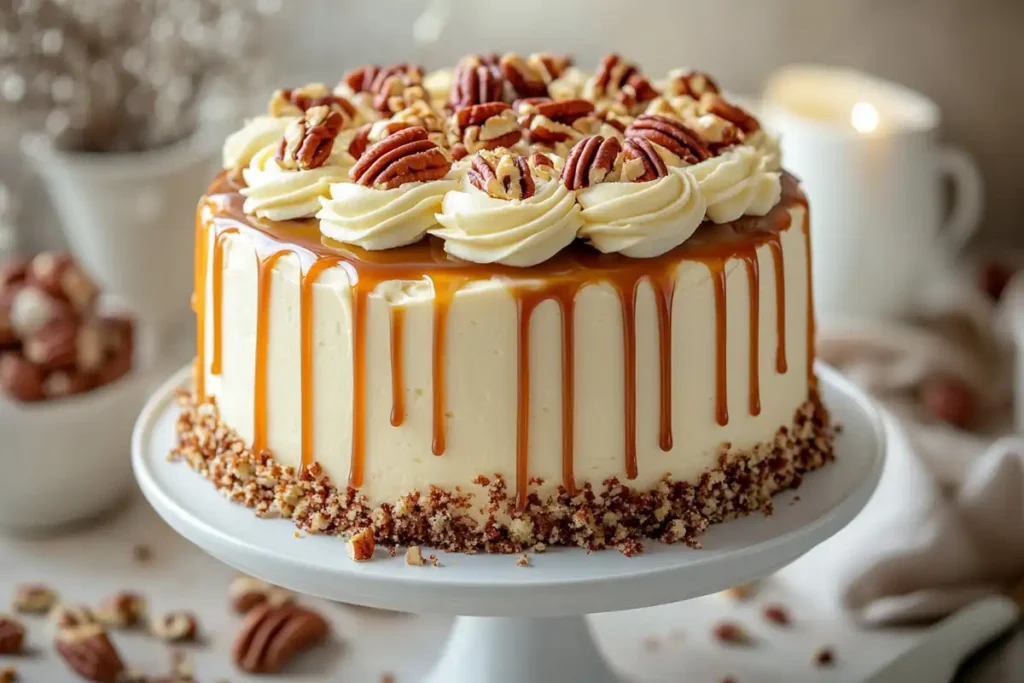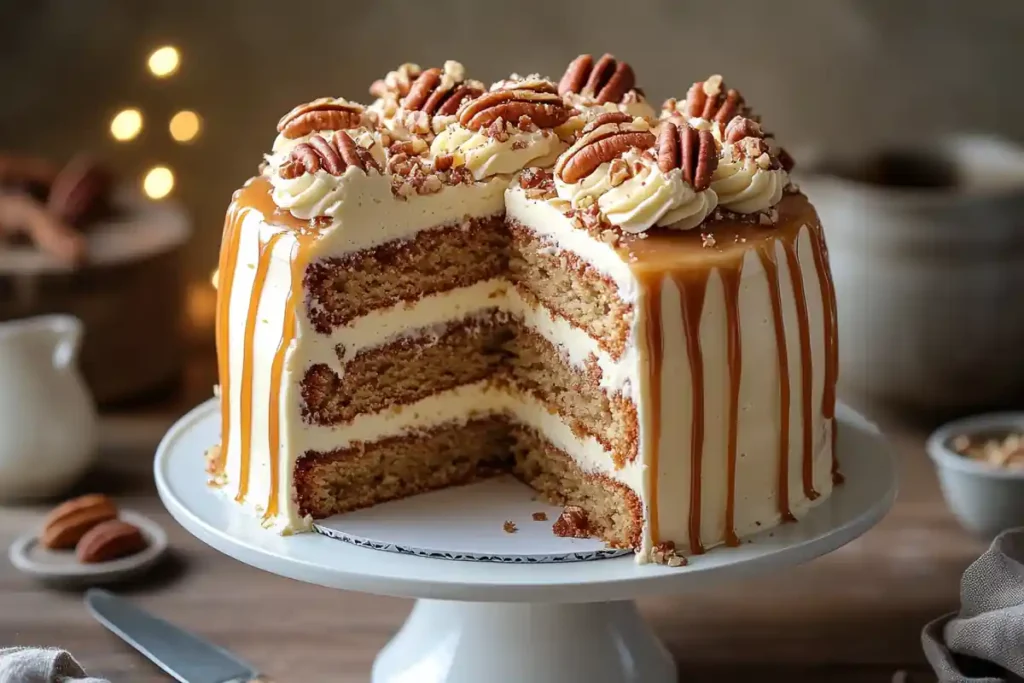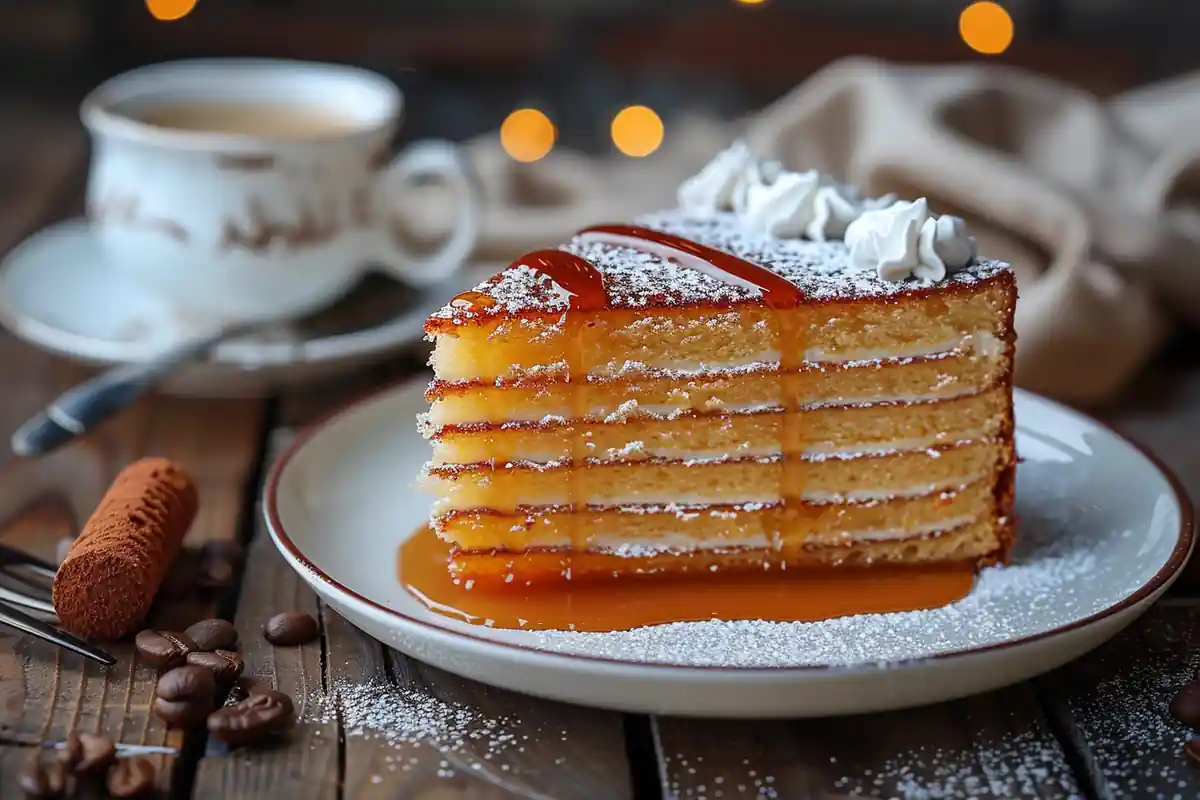Introduction
If you’re a fan of buttery, rich, and slightly nutty flavors, then brown butter cake is about to become your new favorite dessert. This decadent treat takes traditional butter cake to the next level by incorporating browned butter, which adds a deep, caramel-like taste that enhances both the cake and its frosting.
In this guide, we’ll cover everything you need to know about brown butter cake—from its unique flavor and history to step-by-step baking instructions. We’ll also explore variations, the best frosting pairings, and common baking mistakes (plus how to avoid them). Whether you’re a seasoned baker or a beginner, this article will help you create the perfect brown butter cake every time.
Now, let’s dive into Part 1: What makes brown butter cake so special?
Table of Contents
1: What is Brown Butter Cake?
The Unique Flavor of Brown Butter
The magic of brown butter cake lies in its key ingredient—browned butter. Unlike regular melted butter, browned butter is cooked until the milk solids caramelize, creating a rich, toasty, and slightly nutty aroma. This extra step intensifies the depth of flavor, making your cake taste more complex and indulgent.
Browning butter transforms its texture and taste, giving the cake a warm, caramelized butter flavor that pairs beautifully with vanilla, chocolate, or even citrus. This process enhances the overall richness, making each bite melt in your mouth.
A Brief History of Brown Butter in Baking
The use of browned butter in baking isn’t new. French pastry chefs have been using beurre noisette (which translates to “hazelnut butter”) for centuries to enrich sauces, pastries, and cakes. This technique eventually made its way into American and European baking, where it became a favorite for enhancing desserts like cookies, blondies, and cakes.
Over time, bakers discovered that using brown butter in cake batter added a new dimension to traditional butter cakes. As a result, brown butter cake has become a beloved recipe in modern bakeries, praised for its toasty, nutty notes and caramelized butter taste.
Why Brown Butter Cake is So Popular?
There’s a reason why so many bakers rave about brown butter cake. Here’s what makes it stand out:
✔ Enhanced Flavor – The caramelized milk solids in brown butter add a deep, nutty richness that regular butter just can’t match.
✔ Moist and Tender Texture – Browning butter doesn’t just improve flavor; it also creates a more delicate, melt-in-your-mouth crumb.
✔ Versatility – You can pair brown butter cake with a variety of frostings, fillings, and add-ins like toasted nuts, caramel, or vanilla bean.
✔ Simple Yet Elegant – This cake is easy to make but has a gourmet feel, making it perfect for birthdays, weddings, or casual indulgence.
Now that we’ve covered what makes brown butter cake special, let’s move on to the ingredients you’ll need to make this delicious dessert!
2: Ingredients & Substitutions
Essential Ingredients for the Perfect Brown Butter Cake
Making a brown butter cake requires a handful of basic ingredients, but each one plays a crucial role in achieving the perfect texture and flavor. Here’s what you’ll need:
- Unsalted Butter – The star ingredient! Browning the butter enhances the cake’s nutty, caramel-like taste.
- All-Purpose Flour – Provides structure while keeping the cake light.
- Brown Sugar & Granulated Sugar – Brown sugar deepens the toasty flavor, while granulated sugar balances sweetness.
- Eggs – Add moisture and richness to the cake.
- Vanilla Extract – Complements the brown butter’s warmth.
- Baking Powder & Baking Soda – Ensure a fluffy and well-risen cake.
- Salt – A pinch enhances all the other flavors.
- Buttermilk or Whole Milk – Keeps the cake soft and tender.
If you’re making a layered version, consider adding a brown butter frosting or a vanilla bean buttercream for extra richness.
Substituting Ingredients for Dietary Needs
Want to customize your brown butter cake? Here are some easy substitutions:
- Gluten-Free Option – Use a high-quality gluten-free flour blend (like 1:1 baking flour).
- Dairy-Free Version – Substitute butter with vegan butter and use almond milk instead of buttermilk.
- Egg-Free Alternative – Try applesauce, mashed bananas, or a flax egg as a replacement.
- Refined Sugar-Free – Replace white sugar with coconut sugar or maple syrup for a naturally sweetened cake.
These swaps ensure that everyone can enjoy a slice of brown butter cake without compromising on flavor or texture.
Enhancing Flavor: Vanilla, Caramel, and Other Add-Ins
Want to take your cake up a notch? Try these add-ins:
- Toasted Nuts (Pecans, Almonds, or Hazelnuts) – Add crunch and enhance the nuttiness.
- Caramel Swirls – Drizzle caramel into the batter for an extra buttery-sweet kick.
- Spices (Cinnamon, Nutmeg, or Cardamom) – A touch of spice pairs beautifully with brown butter.
- Chocolate Chips – Because who doesn’t love a hint of chocolate in their cake?
Adding these ingredients makes your brown butter cake unique and full of complex flavors.
3: Step-by-Step Guide to Making Brown Butter Cake

How to Brown Butter Properly for the Best Flavor
The key to a flavorful brown butter cake is getting the butter just right. Here’s how:
- Melt the butter in a light-colored pan over medium heat. (A light pan helps you see the color change.)
- Stir constantly as the butter melts and begins to foam.
- Watch for color change – after a few minutes, the butter will turn golden brown, and you’ll notice a nutty aroma.
- Remove from heat immediately once the brown specks appear. Let it cool before using in your cake batter.
Browning butter enhances the cake’s depth of flavor, so don’t skip this step!
Mixing the Batter: Tips for a Fluffy, Moist Cake
Now that your butter is ready, it’s time to mix the batter:
- Whisk the dry ingredients – flour, baking powder, baking soda, and salt – together in a bowl.
- In another bowl, mix the sugar and brown butter until smooth.
- Add eggs one at a time, beating well after each addition.
- Mix in the vanilla extract and buttermilk for extra moisture.
- Slowly incorporate the dry ingredients into the wet mixture, stirring until just combined.
Overmixing can make the cake dense, so mix only until the flour disappears.
Baking the Cake: Ideal Temperature and Baking Time
Follow these steps for a perfect bake:
- Preheat the oven to 350°F (175°C).
- Grease and flour your cake pan to prevent sticking.
- Pour the batter evenly into the pan and smooth the top.
- Bake for 30-40 minutes, or until a toothpick inserted in the center comes out clean.
If making cupcakes, reduce the baking time to 18-22 minutes.
Cooling and Storing the Cake for Maximum Freshness
Once baked, let the cake cool completely before frosting. Here’s how to store it:
- At room temperature: Wrap in plastic wrap and store for up to 3 days.
- In the fridge: Keeps fresh for up to a week.
- Freezing option: Wrap tightly and freeze for up to 3 months.
Now that your brown butter cake is ready, let’s move on to the best frosting and topping choices!
4: Brown Butter Frosting and Toppings

Best Frosting Options for Brown Butter Cake
A great cake deserves an equally delicious frosting. When it comes to brown butter cake, the right frosting can elevate its rich, nutty flavors. Here are some of the best frosting options to pair with this cake:
- Brown Butter Cream Cheese Frosting – A tangy, creamy topping that complements the deep caramel notes of the cake.
- Vanilla Bean Buttercream – The smooth, classic choice that enhances the cake’s toasty flavors.
- Chocolate Ganache – A decadent, velvety chocolate topping that adds a luxurious contrast.
- Caramel Frosting – A sweet and buttery option that blends beautifully with brown butter cake.
Each of these frostings enhances the cake’s depth, making every bite even more irresistible.
Toppings & Garnishes: Nuts, Caramel, Chocolate, and More
If you want to take your brown butter cake to the next level, consider adding toppings! Some of the best garnishes include:
- Toasted pecans or walnuts – Add crunch and amplify the nutty undertones of the brown butter.
- Caramel drizzle – A sweet finishing touch that complements the cake’s buttery richness.
- Shaved chocolate or cocoa nibs – For a hint of bitterness to balance the sweetness.
- Sea salt flakes – A sprinkle of salt enhances the flavors and adds a gourmet touch.
By mixing and matching frostings with these toppings, you can create a customized brown butter cake that suits any occasion.
5: Variations of Brown Butter Cake
Brown Butter Caramel Cake: A Sweet & Buttery Twist
If you love caramel, this version of brown butter cake is for you! By adding a caramel filling or incorporating caramel sauce into the batter, you can create a cake that is extra sweet, gooey, and indulgent.
How to Make It:
- Add ½ cup of caramel sauce to the cake batter before baking.
- Once baked, drizzle extra caramel over the top for a glossy, decadent finish.
- Pair with caramel buttercream or brown butter frosting for maximum flavor.
Brown Butter Cake with Fruits and Nuts
For a more textured and flavorful experience, try adding fruits and nuts to your cake. Some great combinations include:
- Brown Butter Apple Cake – Add chopped apples and a hint of cinnamon for a cozy fall treat.
- Pecan Brown Butter Cake – Toasted pecans mixed into the batter enhance the nuttiness of the cake.
- Berry Brown Butter Cake – Blueberries or raspberries provide a juicy contrast to the rich, buttery cake.
These variations bring out the natural sweetness of the ingredients while adding an extra layer of flavor and texture.
Triple Brown Butter Cake for Intense Flavor
For serious brown butter lovers, this variation intensifies the flavor by using brown butter in three different elements:
- In the cake batter – The base of any good brown butter cake.
- In the frosting – A brown butter cream cheese frosting makes this even more indulgent.
- As a drizzle on top – Melt extra brown butter and lightly drizzle it over the finished cake for a bold, nutty finish.
This variation is the ultimate way to enjoy the deep, caramelized taste of brown butter.
For more delicious desserts, check out this brownie cake recipe for another rich and chocolatey treat!
6: Common Mistakes & How to Avoid Them
Even though brown butter cake is a delightful dessert, it’s easy to make a few mistakes along the way. Here are some of the most common issues and how to fix them.
Overbrowning Butter: When It’s Too Dark
Browning butter is a crucial step, but it can quickly go from perfect to burnt if you’re not careful.
How to Avoid This:
- Use a light-colored pan so you can see the butter’s color change.
- Stir constantly and watch for golden brown specks—not black ones!
- Remove from heat immediately once it reaches a nutty aroma and a deep golden hue.
If the butter turns too dark or smells burnt, it’s best to start over.
Why Is My Cake Too Dry or Too Dense?
A dry or dense brown butter cake can be disappointing, but there are ways to prevent this.
How to Fix It:
- Measure flour correctly – Spoon it into the measuring cup instead of scooping directly from the bag.
- Don’t overmix – Mix until the ingredients are just combined. Overmixing develops too much gluten, making the cake dense.
- Check baking time – Overbaking dries out the cake. Start checking for doneness a few minutes before the recommended time.
A moist, tender brown butter cake comes from proper mixing, measuring, and baking techniques!
Frosting Issues: Curdled or Runny Buttercream?
If your frosting is separating or too thin, here’s how to fix it.
Solutions:
- If the frosting looks curdled, keep mixing! Sometimes, it just needs more whipping.
- If it’s too runny, chill it for 15 minutes before continuing.
- Use room-temperature butter—cold butter won’t mix properly, and melted butter will make the frosting soupy.
By following these tips, you’ll ensure your frosting is smooth, creamy, and perfect for your brown butter cake!
7: FAQs
Here are some common questions about brown butter cake to help you bake with confidence.
What makes brown butter cake different from regular butter cake?
The main difference is the use of browned butter instead of regular butter. Browning butter creates a nutty, caramelized flavor that adds depth to the cake. It also enhances the overall richness, making the cake more flavorful than a standard butter cake.
Can I make brown butter cake without eggs?
Yes! You can substitute eggs with:
- Applesauce (¼ cup per egg) for a moist texture
- Mashed bananas (½ banana per egg) for natural sweetness
- Flax egg (1 tbsp flaxseed + 3 tbsp water) for a vegan option
These alternatives work well, though they may slightly change the texture of the cake.
How do I store brown butter cake to keep it fresh?
To keep your cake fresh and delicious:
- Store it at room temperature in an airtight container for up to 3 days.
- Refrigerate for up to a week, but let it come to room temperature before serving.
- Freeze for up to 3 months—wrap slices tightly in plastic wrap and store in an airtight bag.
Can I freeze brown butter cake for later?
Absolutely! Freezing is a great way to enjoy brown butter cake anytime. Just wrap it well, and when ready to eat, let it thaw at room temperature for a few hours.
8: Serving and Presentation Tips

Once your brown butter cake is perfectly baked and frosted, it’s time to serve it in a way that truly highlights its rich flavor and beautiful texture. Here are some expert tips for presenting and serving it like a pro.
How to Slice Brown Butter Cake Neatly
Cutting a cake seems simple, but getting clean, bakery-style slices can be tricky.
Tips for Clean Cake Slices:
- Use a sharp knife and wipe it clean between each cut.
- Chill the cake slightly before slicing to help it hold its shape.
- Warm the knife in hot water for smooth, even cuts.
For layered brown butter cake, a serrated knife works best to prevent crumbling.
Best Ways to Serve Brown Butter Cake
This cake is delicious on its own, but you can elevate it further with simple accompaniments.
Serving Ideas:
- With a scoop of vanilla bean ice cream – The cold and creamy texture pairs beautifully with the nutty cake.
- Drizzled with homemade caramel sauce – A warm drizzle enhances the buttery richness.
- Paired with coffee or tea – The cake’s deep flavors match perfectly with a bold espresso or a spiced chai tea.
- Topped with fresh berries – Strawberries, raspberries, or blueberries add a refreshing contrast.
By serving brown butter cake with thoughtful pairings, you can turn a simple dessert into a gourmet experience.
9: Final Thoughts & Summary
Making the perfect brown butter cake is easier than you think, and with the right techniques, you can create a dessert that is rich, flavorful, and utterly irresistible.
Why You Should Try Brown Butter Cake
If you love cakes with deep, nutty, caramelized flavors, this recipe is a must-try. The process of browning butter takes only a few minutes, but the result is a cake with unparalleled richness. Whether you enjoy it plain, layered with frosting, or dressed up with toppings, this cake is sure to impress.
Quick Recap: Key Takeaways
Here’s a quick look at what we covered in this guide:
✔ Brown butter enhances the cake’s flavor by adding a deep, toasty, and caramel-like taste.
✔ The right ingredients matter – from quality butter to proper flour measurements.
✔ Baking techniques make all the difference – avoid overmixing, overbaking, or skipping the cooling process.
✔ Pairing and presentation elevate the cake – serve with ice cream, caramel, or coffee for a gourmet touch.
✔ Customization is easy – try variations like brown butter caramel cake or add toasted nuts for extra crunch.
Your Turn to Bake!
Now that you have everything you need to bake a perfect brown butter cake, it’s time to get into the kitchen and try it yourself! Whether you follow the classic recipe or experiment with your own variations, this cake is sure to be a crowd-pleaser.
For more delicious baking inspiration, check out other dessert recipes to expand your baking skills! 🍰✨

